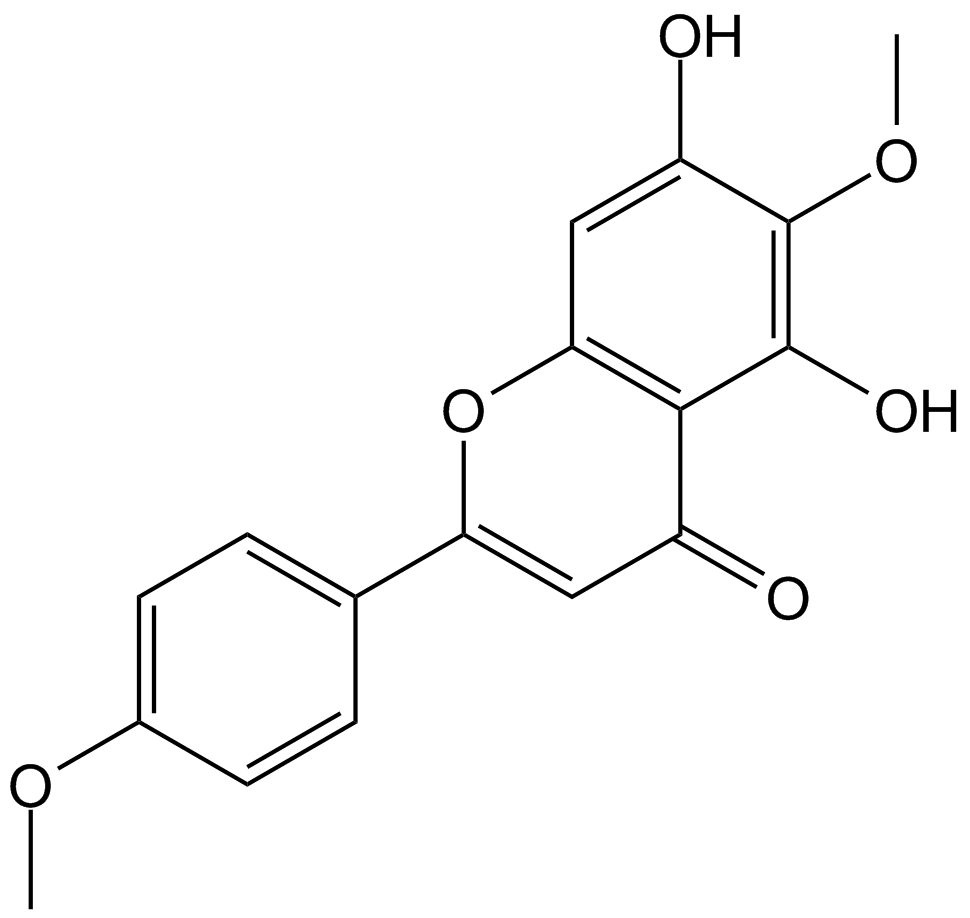Pectolinarigenin |
| Catalog No.GN10183 |
Pectolinarigenin, as a flavonoids compound, which can be isolated from the aerial parts of C.
Products are for research use only. Not for human use. We do not sell to patients.

Cas No.: 520-12-7
Sample solution is provided at 25 µL, 10mM.
Pectolinarigenin, as a flavonoids compound, which can be isolated from the aerial parts of C. chanroenicum has been displayed biologic activities such as anti-inflammation and anti-allergy[1]. It also repressed cancer growth in vitro, including lung cancer, breast cancer and colorectal adenocarcinoma[2].
In vitro, pectolinarigenin inhibited significantly the growth of the SK-HEP-1 liver cancer cells and exhibited an IC50 of 10 µM, while against normal cells the cytotoxic effects were much less pronounced[3]. In vitro experiment it demenstrated that Pectolinarigenin at 10 µM obviously inhibited ROS accumulation after 24 h-treatment in HepG2 cells and also increased protein expression of NQO-1 and AKR1B10[4]. In vitro, 30 µM pectolinarigenin treatment suppressed melanin biosynthesis without cytotoxicity in melan-a cells[5]. Pectolinarigenin also reduced the lipid contents in vitro[6]. Treatment with 40 µM pectolinarigenin in A375 cells and in B16 cells increased >6-fold and 10-fold apoptotic rate compared with the respective untreated control groups[7].
In vivo, 10 mg/kg pectolinarigenin in mice could activate the Nrf2/ARE pathway and induced antioxidant enzymes as the same manner as the results from HepG2 cells[4]. In vivo efficacy test it shown that mice were administrated pectolinarigenin (20 mg/kg/2 days and 50 mg/kg/2 days) intraperitoneally blocked STAT3 activation and disturbed tumor growth and metastasis with superior pharmacodynamic properties[8]. In vivo test it exhibited that mice were administrated with 25 mg/kg/d orally for 7 days or 14 days effectively ameliorated kidney injury and tubulointerstitial fibrosis after unilateral ureteral obstruction (UUO) surgery[9].
References:
[1] H. Lim, et al. Anti-inflammatory activity of pectolinarigenin and pectolinarin isolated from Cirsium chanroenicum Biol. Pharm. Bull., 31 (2008), pp. 2063-2067.
[2] M. Bonesi, et al. In vitro biological evaluation of novel 7-O dialkylaminoalkyl cytotoxic pectolinarigenin derivatives against a panel of human cancer cell lines Bioorg. Med. Chem. Lett., 18 (2008), pp. 5431-5434.
[3] Liu S, et al. Pectolinarigenin flavonoid exhibits selective anti-proliferative activity in cisplatin-resistant hepatocellular carcinoma, autophagy activation, inhibiting cell migration and invasion, G2/M phase cell cycle arrest and targeting ERK1/2 MAP kinases. J BUON. 2020 Jan-Feb;25(1):415-420.
[4] Shiraiwa M, et al. Pectolinarigenin Induces Antioxidant Enzymes through Nrf2/ARE Pathway in HepG2 Cells. Antioxidants (Basel). 2022 Mar 30;11(4):675.
[5] Lee S, et al. Pectolinarigenin, an aglycone of pectolinarin, has more potent inhibitory activities on melanogenesis than pectolinarin. Biochem Biophys Res Commun. 2017;493:765-772.
[6] Zhang Y, Wan C, Song Z, Meng W, Wang S, Lan Z. Pectolinarigenin reduces the expression of sterol regulatory element-binding proteins and cellular lipid levels. Biosci Biotechnol Biochem. 2022 Aug 24;86(9):1220-1230.
[7] Deng Y, et al. Pectolinarigenin inhibits cell viability, migration and invasion and induces apoptosis via a ROS-mitochondrial apoptotic pathway in melanoma cells. Oncol Lett. 2020 Oct;20(4):116.
[8] Zhang T, et al. Pectolinarigenin acts as a potential anti-osteosarcoma agent via mediating SHP-1/JAK2/STAT3 signaling. Biomed Pharmacother. 2022 Sep;153:113323.
[9] Li Y, et al. Natural flavonoid pectolinarigenin alleviated kidney fibrosis via inhibiting the activation of TGFβ/SMAD3 and JAK2/STAT3 signaling. Int Immunopharmacol. 2021 Feb;91:107279.
Average Rating: 5 (Based on Reviews and 30 reference(s) in Google Scholar.)
GLPBIO products are for RESEARCH USE ONLY. Please make sure your review or question is research based.
Required fields are marked with *




















